2008 KIA CERATO ECU
[x] Cancel search: ECUPage 17 of 327

37
1 23456789
Knowing your vehicle
Operating door locks from
outside the vehicle
Turn the key toward rear of vehicleto unlock and toward front of vehi-
cle to lock.
Doors can also be locked and unlocked with the transmitter key. Once the doors are unlocked, it
may be opened by pulling the door
handle.
When closing the door, push the door by the hand. Make sure that
doors are closed securely.
If you lock/unlock the front door with a key, all vehicle doors will
lock/unlock automatically. (ifequipped)
❈ If your vehicle is equipped with the
remote keyless entry system,
there is no key lock on the front
passenger's door. To lock a door without the key, push
the inside door lock button (1) or
door lock switch (2, if equipped) to
the “LOCK” position and close thedoor (3).
✽✽
NOTICE
Always remove the ignition key, engage the parking brake, close allwindows and lock all doors when
leaving your vehicle unattended.
DOOR LOCKS
OLD026004
LockUnlock
1LDA2005
Page 28 of 327
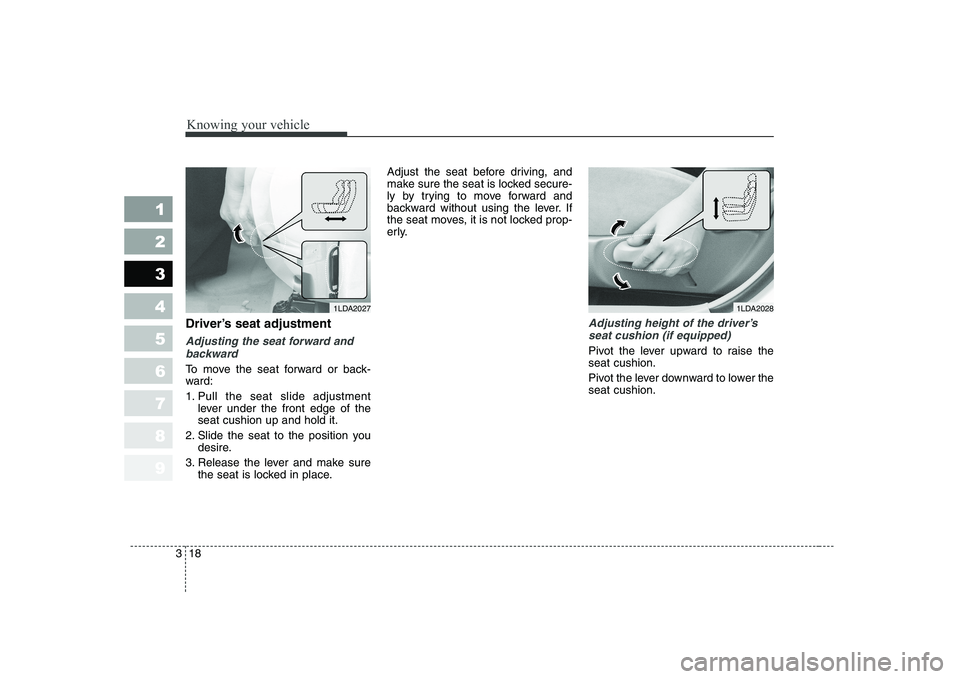
Knowing your vehicle
18
3
1 23456789
Driver’s seat adjustment
Adjusting the seat forward and
backward
To move the seat forward or back-
ward:
1. Pull the seat slide adjustment lever under the front edge of the seat cushion up and hold it.
2. Slide the seat to the position you desire.
3. Release the lever and make sure the seat is locked in place. Adjust the seat before driving, and
make sure the seat is locked secure-
ly by trying to move forward and
backward without using the lever. If
the seat moves, it is not locked prop-
erly.
Adjusting height of the driver’s
seat cushion (if equipped)
Pivot the lever upward to raise the seat cushion.
Pivot the lever downward to lower the seat cushion.
1LDA20271LDA2028
Page 32 of 327
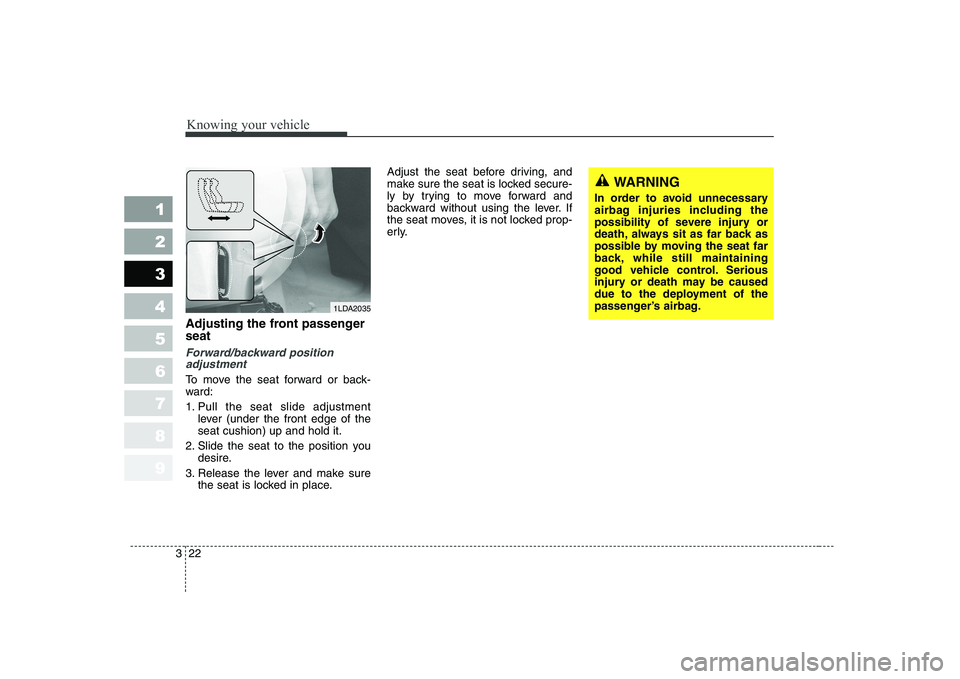
Knowing your vehicle
22
3
1 23456789
Adjusting the front passenger seat
Forward/backward position
adjustment
To move the seat forward or back-
ward:
1. Pull the seat slide adjustment
lever (under the front edge of the seat cushion) up and hold it.
2. Slide the seat to the position you desire.
3. Release the lever and make sure the seat is locked in place. Adjust the seat before driving, and
make sure the seat is locked secure-
ly by trying to move forward and
backward without using the lever. If
the seat moves, it is not locked prop-
erly.
1LDA2035
WARNING
In order to avoid unnecessary
airbag injuries including the
possibility of severe injury or
death, always sit as far back as
possible by moving the seat far
back, while still maintaining
good vehicle control. Serious
injury or death may be caused
due to the deployment of the
passenger’s airbag.
Page 38 of 327

Knowing your vehicle
28
3
1 23456789
To unfold the rear seat:
1. Move the rear center shoulder belt
(1 , if equipped) to the side so that it
is clear of the seatback.
2. Lift and push the seatback backward firmly until it clicks into place ( 2).
Move and push the seat cushion
downward firmly to the proper posi-
tion (5 Door, if equipped).
3. Return the rear safety belt to the proper position.
✽✽ NOTICE
If the seat belt is locked during the seatback folding, pull out and
retract the seat belt to release it.
CAUTION
When returning the rear seat- backs to the upright position,remember to return the rear shoulder belts to their properposition.
Do not remove the floor carpet in your vehicle. Emission con-trol system components cause high exhaust tempera-tures under the floor.
WARNING - Cargo
Cargo should always be
secured to prevent it from being
thrown about the vehicle in a
collision and causing injury to
the vehicle occupants.
CAUTION
Make sure the engine is off, the transaxle is in P and theparking brake is appliedwhenever loading or unload- ing cargo. Vehicle may move ifshift lever is inadvertentlymoved to another position.
Be careful when loading cargo through the rear passengerseats to prevent damage tothe vehicle interior.
When cargo is loaded through the rear passenger seats,ensure the cargo is properly secured to prevent it frommoving while driving.Unsecured cargo in the pas- senger compartment cancause damage to the vehicleor injury to it’s occupants.
1LDN3026A
Page 51 of 327
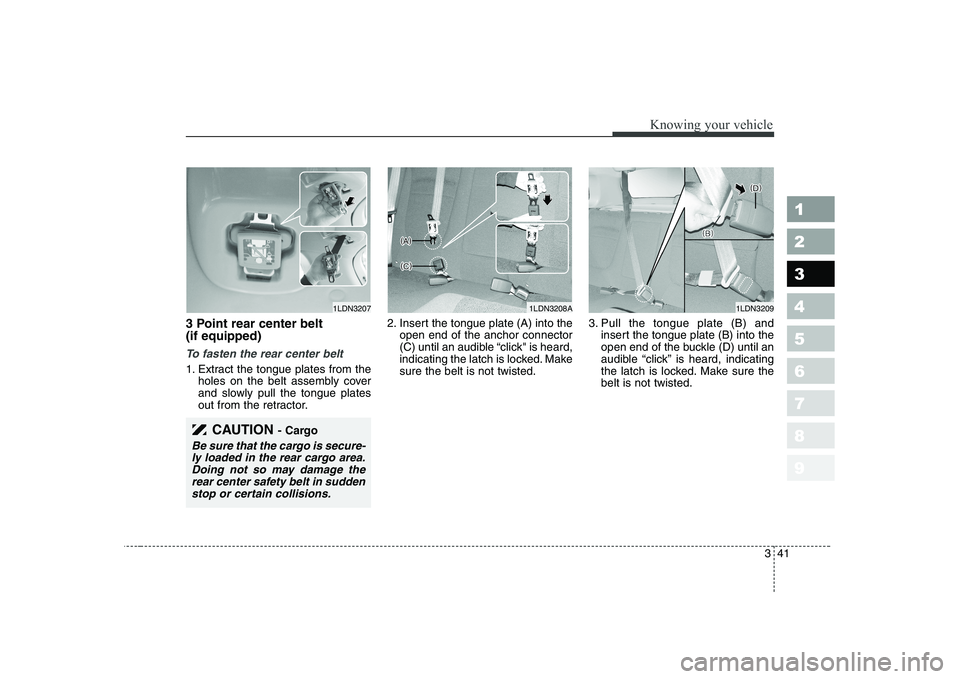
341
1 23456789
Knowing your vehicle
3 Point rear center belt (if equipped)
To fasten the rear center belt
1. Extract the tongue plates from theholes on the belt assembly cover
and slowly pull the tongue plates
out from the retractor. 2. Insert the tongue plate (A) into the
open end of the anchor connector
(C) until an audible “click" is heard,
indicating the latch is locked. Makesure the belt is not twisted. 3. Pull the tongue plate (B) and
insert the tongue plate (B) into the
open end of the buckle (D) until an
audible “click” is heard, indicating
the latch is locked. Make sure thebelt is not twisted.
1LDN32071LDN3208A1LDN3209
CAUTION - Cargo
Be sure that the cargo is secure-
ly loaded in the rear cargo area. Doing not so may damage therear center safety belt in suddenstop or certain collisions.
Page 56 of 327
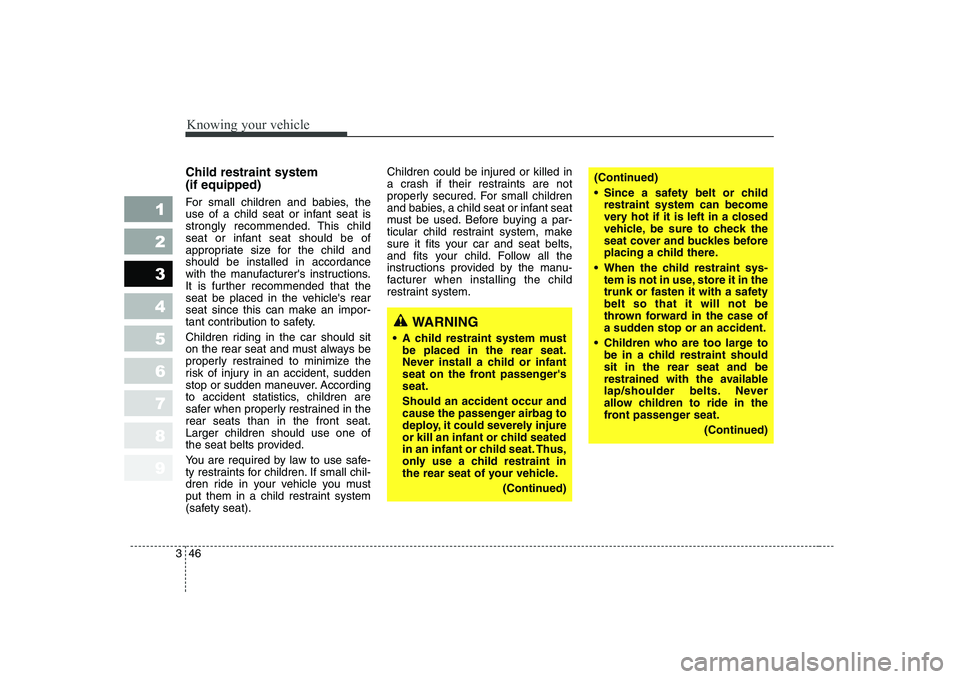
Knowing your vehicle
46
3
1 23456789
Child restraint system (if equipped)
For small children and babies, the
use of a child seat or infant seat is
strongly recommended. This child
seat or infant seat should be of
appropriate size for the child andshould be installed in accordance
with the manufacturer's instructions.
It is further recommended that the
seat be placed in the vehicle's rear
seat since this can make an impor-
tant contribution to safety.
Children riding in the car should sit
on the rear seat and must always be
properly restrained to minimize the
risk of injury in an accident, sudden
stop or sudden maneuver. According
to accident statistics, children are
safer when properly restrained in therear seats than in the front seat.Larger children should use one of
the seat belts provided.
You are required by law to use safe-
ty restraints for children. If small chil-
dren ride in your vehicle you must
put them in a child restraint system
(safety seat). Children could be injured or killed in
a crash if their restraints are not
properly secured. For small children
and babies, a child seat or infant seat
must be used. Before buying a par-
ticular child restraint system, make
sure it fits your car and seat belts,
and fits your child. Follow all the
instructions provided by the manu-
facturer when installing the child
restraint system.
WARNING
A child restraint system must be placed in the rear seat.
Never install a child or infant
seat on the front passenger'sseat. Should an accident occur and
cause the passenger airbag to
deploy, it could severely injure
or kill an infant or child seated
in an infant or child seat. Thus,
only use a child restraint in
the rear seat of your vehicle.
(Continued)
(Continued)
Since a safety belt or childrestraint system can become
very hot if it is left in a closed
vehicle, be sure to check the
seat cover and buckles before
placing a child there.
When the child restraint sys- tem is not in use, store it in the
trunk or fasten it with a safetybelt so that it will not be
thrown forward in the case of
a sudden stop or an accident.
Children who are too large to be in a child restraint shouldsit in the rear seat and be
restrained with the available
lap/shoulder belts. Never
allow children to ride in the
front passenger seat.
(Continued)
Page 57 of 327

347
1 23456789
Knowing your vehicle
Installation on the rear seats(Continued)
Always make sure that theshoulder belt portion of the
outboard lap/shoulder belt is
positioned midway over the
shoulder, never across the
neck or behind the back.
Moving the child closer to the
center of the vehicle may help
provide a good shoulder belt
fit. The lap belt portion of thelap/shoulder belt or the center
seat lap belt must always be
positioned as low as possible
on the child's hips and as
snug as possible.
If the seat belt will not proper- ly fit the child, we recommend
the use of an approved boost-
er seat in the rear seat in order
to raise the child's seatingheight so that the seat belt will
properly fit the child.
(Continued)(Continued)
Never allow a child to stand upor kneel on the seat.
Never use an infant carrier or child safety seat that "hooks"
over a seatback; it may not
provide adequate security inan accident.
Never allow a child to be held in a person's arms while they
are in a moving vehicle, asthis could result in serious
injury to the child in the event
of an accident or a sudden
stop. Holding a child in a mov-
ing vehicle does not provide
the child with any means of
protection during an accident,
even if the person holding the
child is wearing a seat belt.
WARNING
Before installing the child restraint system, read the
instructions supplied by the
child restraint system manu-
facturer.
Failure to observe this manual instructions regarding childrestraint system and the
instructions provided with the
child restraint system could
increase the chance and/or
severity of injury in an acci-dent.
Page 59 of 327
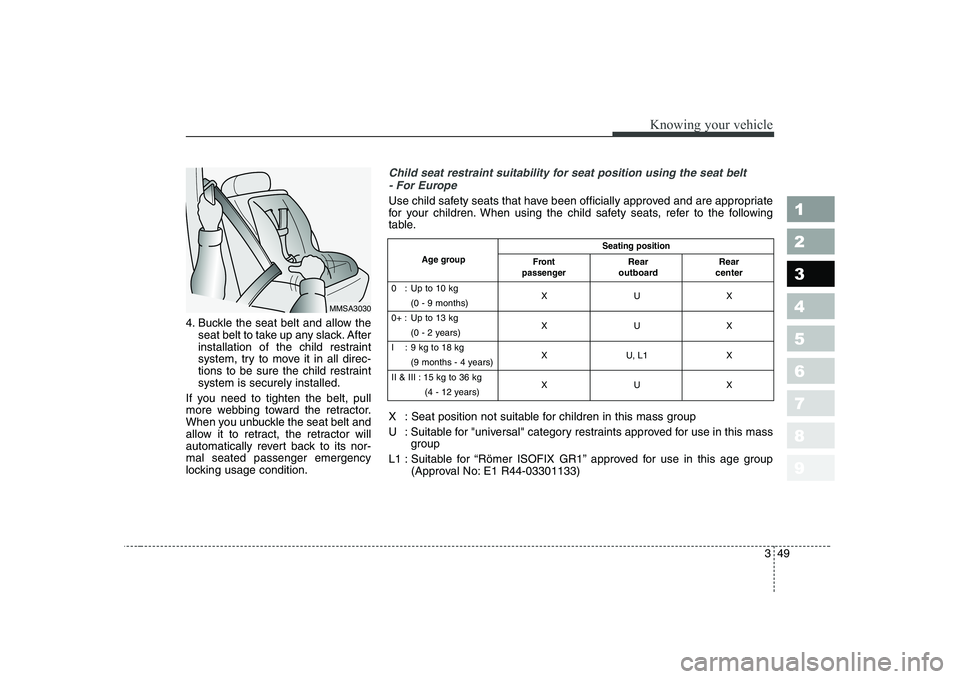
349
1 23456789
Knowing your vehicle
4. Buckle the seat belt and allow theseat belt to take up any slack. After
installation of the child restraint
system, try to move it in all direc-
tions to be sure the child restraintsystem is securely installed.
If you need to tighten the belt, pull
more webbing toward the retractor.
When you unbuckle the seat belt and
allow it to retract, the retractor will
automatically revert back to its nor-mal seated passenger emergency
locking usage condition.
MMSA3030
Child seat restraint suitability for seat position using the seat belt - For Europe
Use child safety seats that have been officially approved and are appropriate
for your children. When using the child safety seats, refer to the following
table.
X : Seat position not suitable for children in this mass group
U : Suitable for "universal" category restraints approved for use in this mass group
L1 : Suitable for “Römer ISOFIX GR1” approved for use in this age group (Approval No: E1 R44-03301133)
Seating position
Age group
0 : Up to 10 kg XUX
(0 - 9 months)
0+ : Up to 13 kg XUX
(0 - 2 years)
I : 9 kg to 18 kg X U, L1 X
(9 months - 4 years)
II & III : 15 kg to 36 kg XUX
(4 - 12 years)
Front
passengerRear
outboard Rear
center